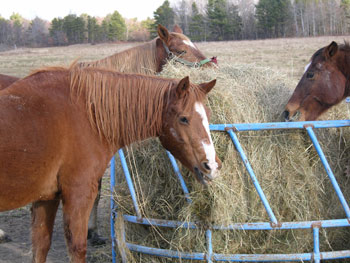Winterguide 2005 | view story as a pdf
By Stacey Chase
“The Horsey Set” takes on a whole new meaning at this farm in Biddeford
All the pretty horses that dot the pastures at Bush Brook Farm in Biddeford do not have pretty pasts. Each of the 30 wild horses–mostly mustangs–has a hard-luck story that has landed him or her in Maine, after being captured on United States government territory out West. Like a flower that blooms out of season, an early snowfall or unexpected love, these small sturdy horses native to the western plains are equally out of place and particularly beautiful misfits in Maine, though they’ve long been considered outlaws among the horsey set.
Driving along West Street and seeing them out there in the snow, you can’t help but wonder, “Haven’t we seen this movie before? And didn’t it star Clark Gable and Marilyn Monroe?”
“I’ve fallen in love with these mustangs because their chances of finding homes are slim unless someone helps them,” says horse rescuer Mona Jerome, explaining her keen interest in a breed often considered the equivalent of a mutt. Clark Gable’s cowboy in The Misfits disparagingly refers to mustangs as “chicken-feed horses,” good for nothing other than making dog food or cat food. In the movie, old cowboys catch wild mustangs in the desert near Reno, tie old automobile tires around their necks, and moor them out there under the stars until a truck picks them the next day to take them to the slaughterhouse.
Forty years later, the breed is still battered, insulted, and looking for love.
“Not everybody needs to have a horse with papers and champion bloodlines,” Jerome sniffs. “You know, you don’t need that to go on a trail ride. These are wonderful trail horses.”
Better still, you can buy a 2005 mustang for a suggested donation of just $600 if you have the love to back up the bucks.
Jerome, who has been saving mustangs since 1981, is the founder and president of the Ever After Mustang Rescue, Training, and Educational Center at Bush Brook, a nonprofit organization dedicated to rescuing and rehabilitating previously adopted mustangs, finding them new homes, and offering lifetime care to unadoptable horses of all breeds. And even wild horses couldn’t drag this 66-year-old great-grandmother who still mucks out stalls away from her save-a-mustang mission.
“The 30 [mustangs] I have at my barn are only a small drop in the bucket of the number that have been adopted out to the general public who do not keep them,” Jerome says. “They will live out their lives here if I can’t place them, but I’m trying to place them in good homes–and I am very picky about where they go.”
Jerome acquires her mustangs from individuals, agencies, and horse dealers or purchases them outright through the federal Bureau of Land Management’s National Wild Horse and Burro Program.
Under the Wild Free-Roaming Horses and Burros Act, a federal law passed in 1971, the BLM is charged with protecting, managing, and controlling all the wild horses and burros found in 10 western states: Arizona, California, Colorado, Idaho, Montana, Nevada, New Mexico, Oregon, Utah, and Wyoming. Each year, 8,000 to 10,000 of the animals are corralled and sold at auction in an effort to prevent overpopulation.
“If the wild horses and burros were not removed from the rangelands, they’d die of dehydration and starvation,” says program spokeswoman Janet Neal.
Sadly, not all adoptions are successful. “People lose interest because wild horses are skittish,” Jerome says. “Some of them have never had a stable roof over their heads before they get here. But if you don’t work with them, they get worse and worse, and they grow further away from us and it’s harder to make that contact.”
Consider Charlotte, a bay mare rounded up in Nevada and adopted by a fruit farmer in upstate New York who for years let her run free in his orchards. When the farmer died suddenly, Charlotte–15 years old and completely untamed–was moved to Bush Brook, where she’s adjusting to an environment that surely chafes against instinct.
“She’s sweet, sweet natured,” Jerome says of Charlotte, who playfully nudges at the bulging apple in a visitor’s coat pocket until she’s fed. “She’s ready to have a home, but it needs to be a rider who’ll be patient with her. She’s what we call green broke– under saddle, but she’s had no experiences and doesn’t know a whole lot.“
Ginger has a dark brown coat with white socks. “The people who gave her to us let her run free for 13 years of her life. Do you see? She’s still wearing the pink ribbon they put on her tail so she wouldn’t be shot by hunters. She hasn’t been mistreated; her prognosis is excellent.”
Good as Gold is an 11-year-old cream-colored gelding with a flaxen mane and tail, also captured on the Nevada desert but adopted by someone in Pennsylvania, eventually ending up at an auction in Skowhegan. “This horse has definitely been a- bused,” Jerome says angrily, mentioning that the palomino receives massage therapy from a practitioner with human clients who donates her services. “He’s always so tense. He’s always on the defensive, but he’s got an extremely kind eye.”
His pen mate is Thunder. “Thunder arrived on July 4 last summer. He was adopted as a three-year-old by a private party. The same people kept him for five years but they never did anything with him, never socialized him with other horses. Then a carcinoma began to cover his eye and the owners ignored it. So by the time we got him, he’d lost that eye. He’s accustomed to staying outdoors, away from the others except for Good as Gold. They tolerate each other.” So there’s a one-eyed horse out here at night, under the moon. “He’s a challenge,” she says. “But he’s worth it.
“Brave Heart is real pushy. He tore my rotator cuff nudging me the way he would another horse. He doesn’t realize I’m not strong enough!
“Reno is the only one I’ve adopted from the Bureau of Land Management. He’s been here 18 years. Little children can ride him. He’s our ambassador. He spends all of his time with a burro named Chalupa, who’s been here three years. They’re inseparable.
“Lady was black when we first got her. We’ve grown gray together. She’s taken such good care of me! See how friendly she is? She’s 21.”
Then there’s Nevada–he was chronicled in these pages a year ago [“The Misfits,” Winterguide 2004] when he was at Bush Brook for a week of “sensitizing.” It seems to have taken. Still owned by a Buxton woman, “Nevada’s now under the saddle,” says
Jerome. “He went to the Cumberland Fair with a couple of our horses.
“Elephants never forget and never forgive,” Jerome says. “Well, horses never forget but they do forgive, and we have that in our favor.
In successful cases the moment of forgiveness is quite poignant. Ellie Rose of Norfolk, Massachusetts, adopted Shamray from Jerome in 1991 when “she was two and as willful as any two-year-old child.
“At first, she’d strike out with her front legs–rear up,” Rose says on the telephone. “At other times, you could groom her or put the saddle on her. But she always had a very good nature. I think she was testing to see how far she could go.”
Raising Shamray has turned out to be well worth the ride. “You need to be patient,” the 50-year-old mother of three advises anyone interested in owning a wild horse. “You need to be understanding. And you just need to love them…With mustangs, you need to get their trust. Once you have their trust, they’ll do anything for you.”
The spunky Jerome, who has ridden since she was a girl, identifies with the plight of wild mustangs. Like Gable tells Marilyn Monroe, “They’re nothing but misfit horses, honey.” But even Gable’s weather-beaten cowboy is seduced by their free-spirited beauty and eventually gives up mustanging, saying: “It’s like roping a dream now.”
Jerome often wonders if her dream of saving the mustangs isn’t equally elusive.
“Sometimes I ask myself if this isn’t, at my age, part of senility,”she jokes about her passionate commitment to these horses who are directly descended from horses brought in by the Spaniards. “I love horses. I always have. I don’t know where it comes from. I guess it’s just born in you.
“I saw my first wild horse in an old Western when I was a kid–and we’re talking now [the] early to mid 1940s,” she says. “And when I saw the wild horses, I knew I needed to have one of those.”
This winter, Jerome is surrounded by 30 misfits, “more than I can really handle or afford,” and keeping them all has required a quiet heroism. It costs $1,500 a month to board, feed, and provide veterinary care for the mustangs “though, realistically, that figure should be about $4,000,” says Jerome, an LPN who came out of retirement to care for nuns in a convent infirmary three nights a week to support her beloved equines. “I need a slush fund,” she says as the stable door opens to show a light snow beginning to fall.
The mustang rescue, which received its nonprofit 501(c) status in 2003, scrapes by on Jerome’s income, spotty donations, and fundraisers like its ongoing bottle drive, a raffle, and a dance at the local VFW hall. She relies on her husband of 44 years, Bradford, a Secret Service retiree; three of her four children who live in the area; and up to a dozen volunteers to keep the operation running, albeit at a slow gait.
Volunteer Chrissy Parise, a senior at the University of New England, spends about 12 hours a week at Bush Brook working with the mustangs, a breed that has captured her heart. “The most rewarding part is when you have an animal that’s scared of you, and you work with him, and then he’s, like, your best friend,” says Parise, 21.
So what happens if you don’t rescue a mus-tang? “Most of them would go right into Canada and slaughter,” Jerome says. “It’s illegal to capture or shoot any wild mustang on govern- ment land.” Though necessity forced Napoleon’s troops to eat their horses during the seige on Russia, now horsemeat is in demand as “meat for gourmet European tables.
“I want that stressed,” Jerome instructs, “because if they were going to Third World countries to feed the starving…I wouldn’t like it, but I might be able to live with it.”
In naming her nonprofit Ever After Mustang Rescue, Jerome has left out the word too obvious to mention. “It just goes back to childhood and all the stories I loved that ended happily ever after,” she explains. “I still look for that in my stories and my movies. I like that–happily ever after. We hope it turns out that way for these guys.”
For information about adopting or fostering a mustang, or volunteering or becoming a drill-team member at Ever After Mustang Rescue, visit www.mustangrescue.org, or contact Mona Jerome at 463 West Street, Biddeford 04005, mustangs1@earthlink.net or 284-7721.






0 Comments